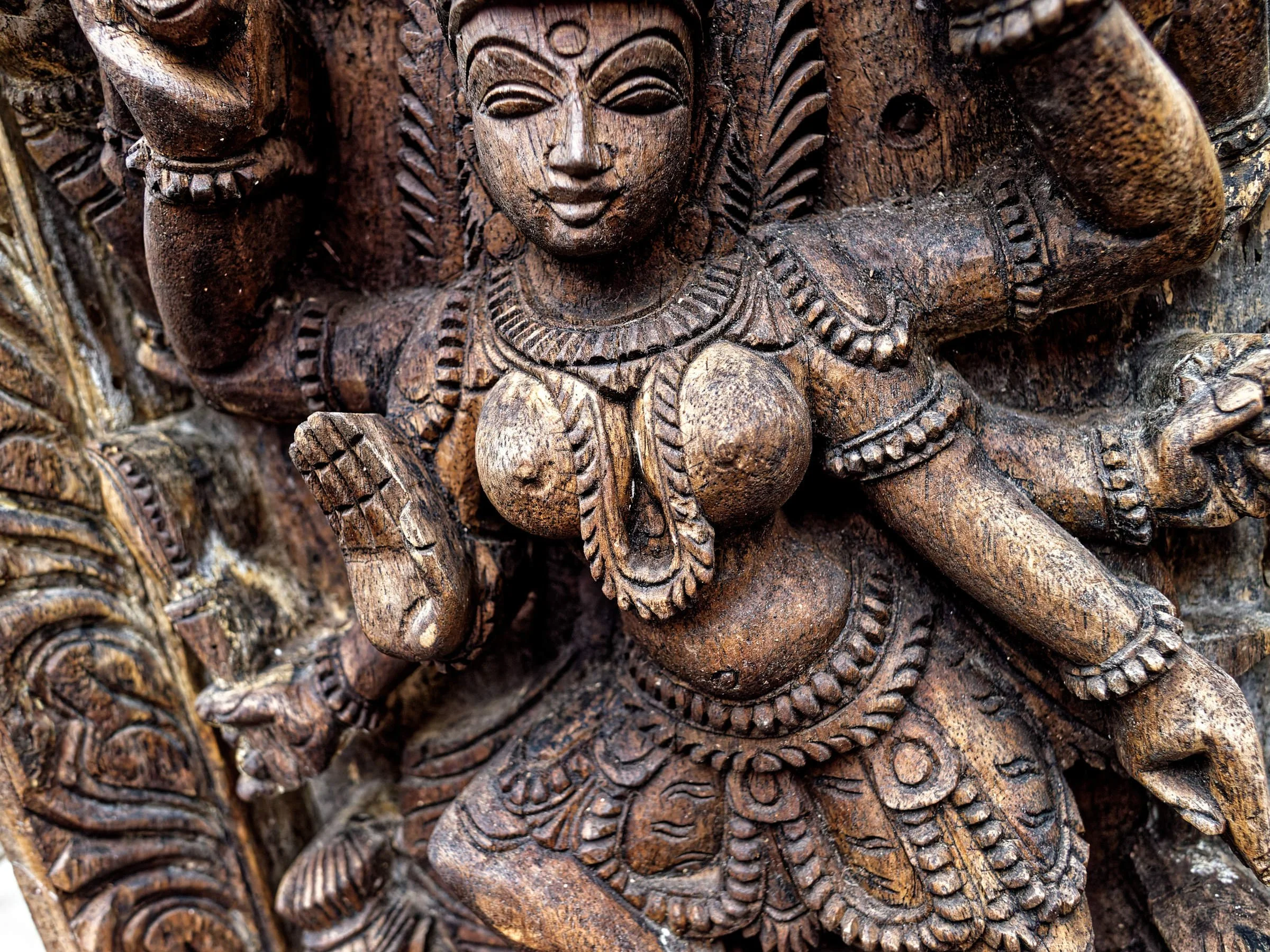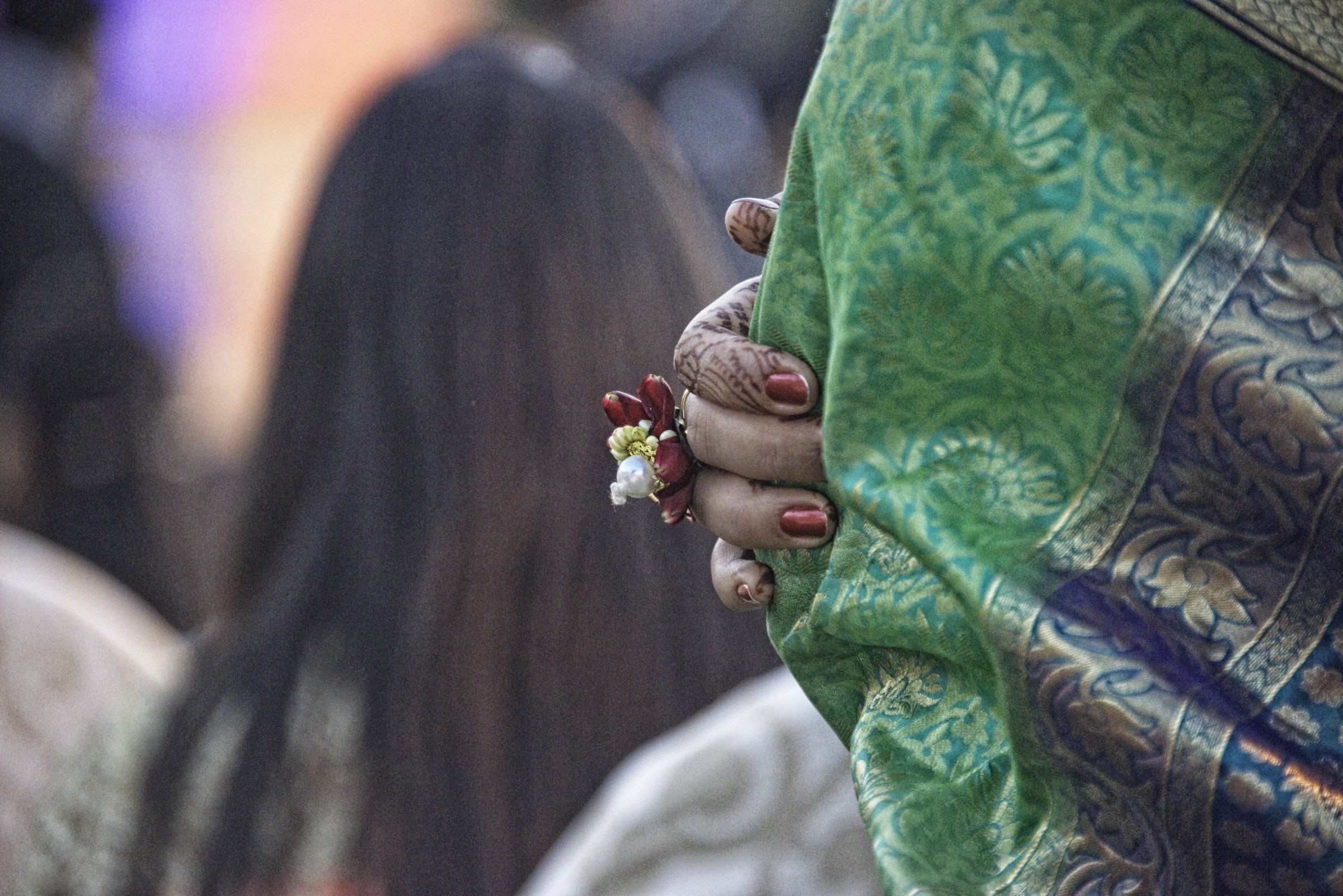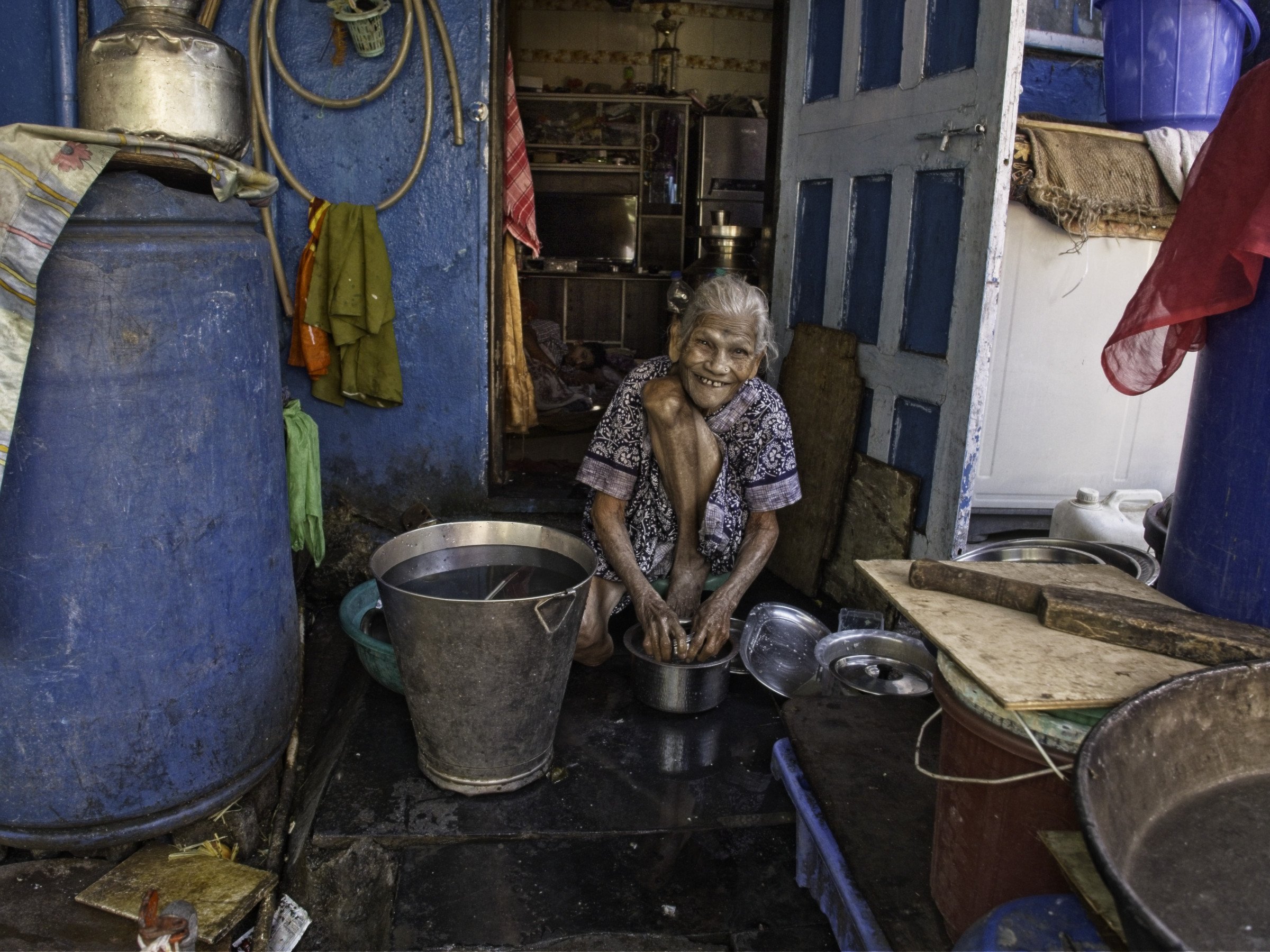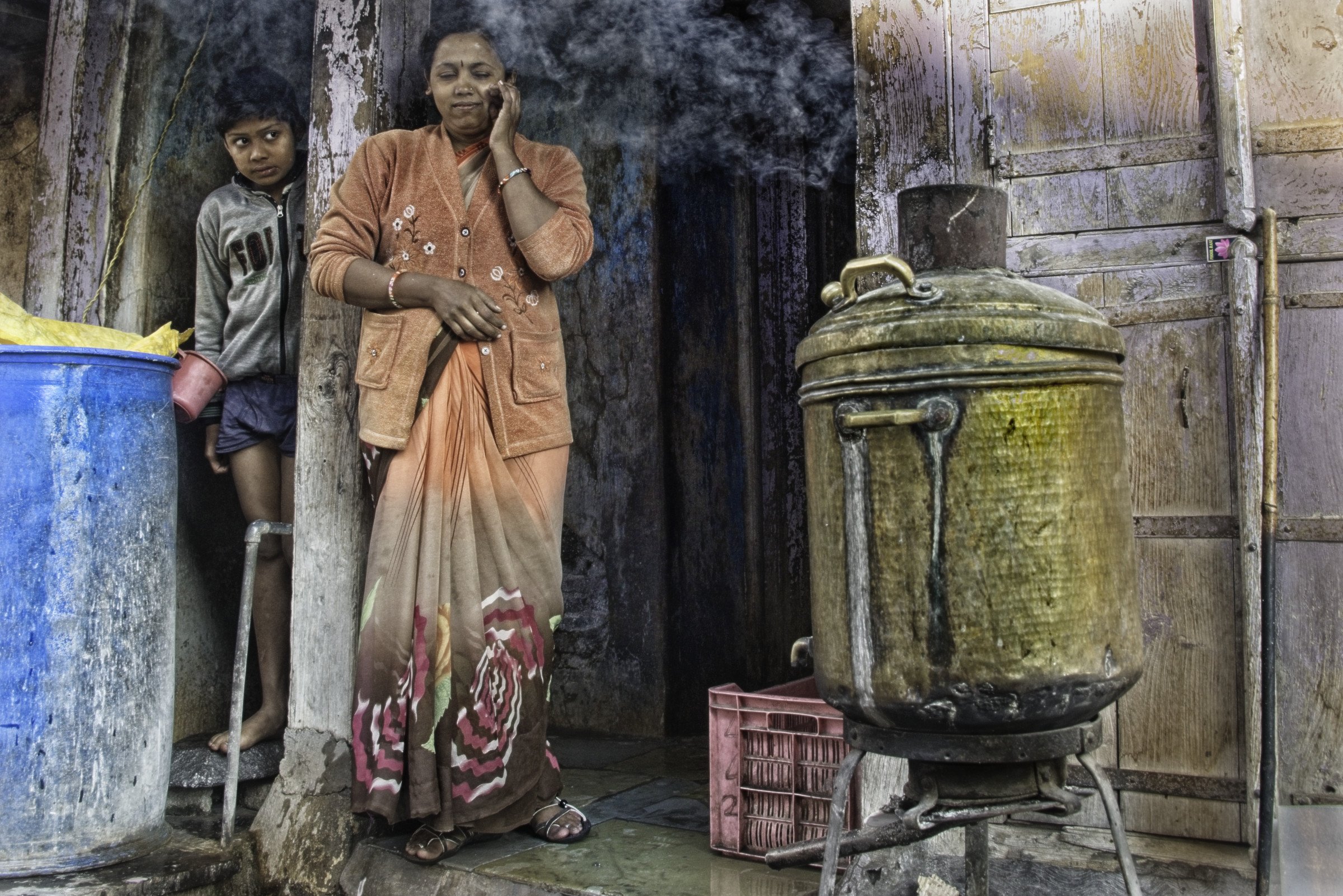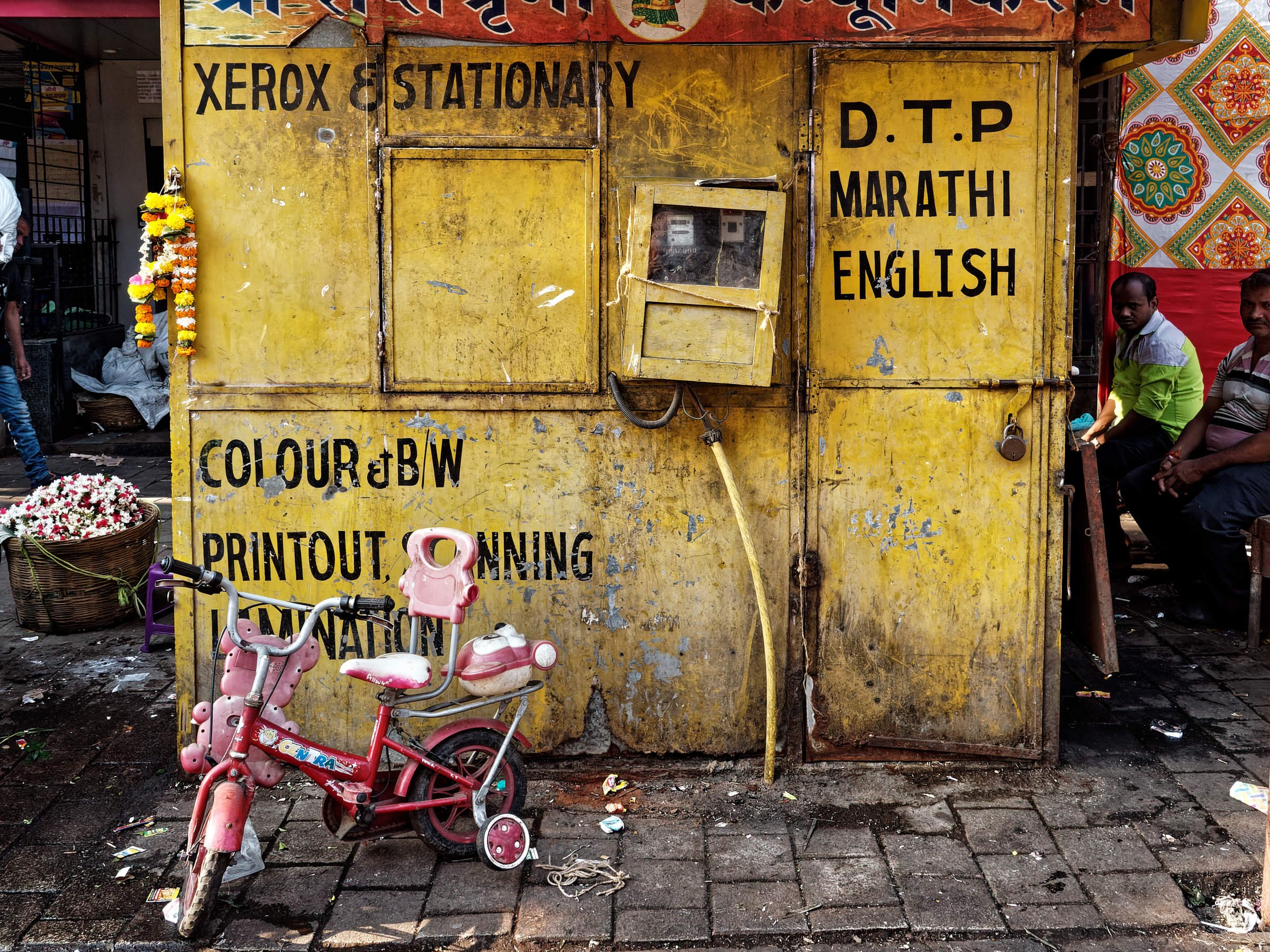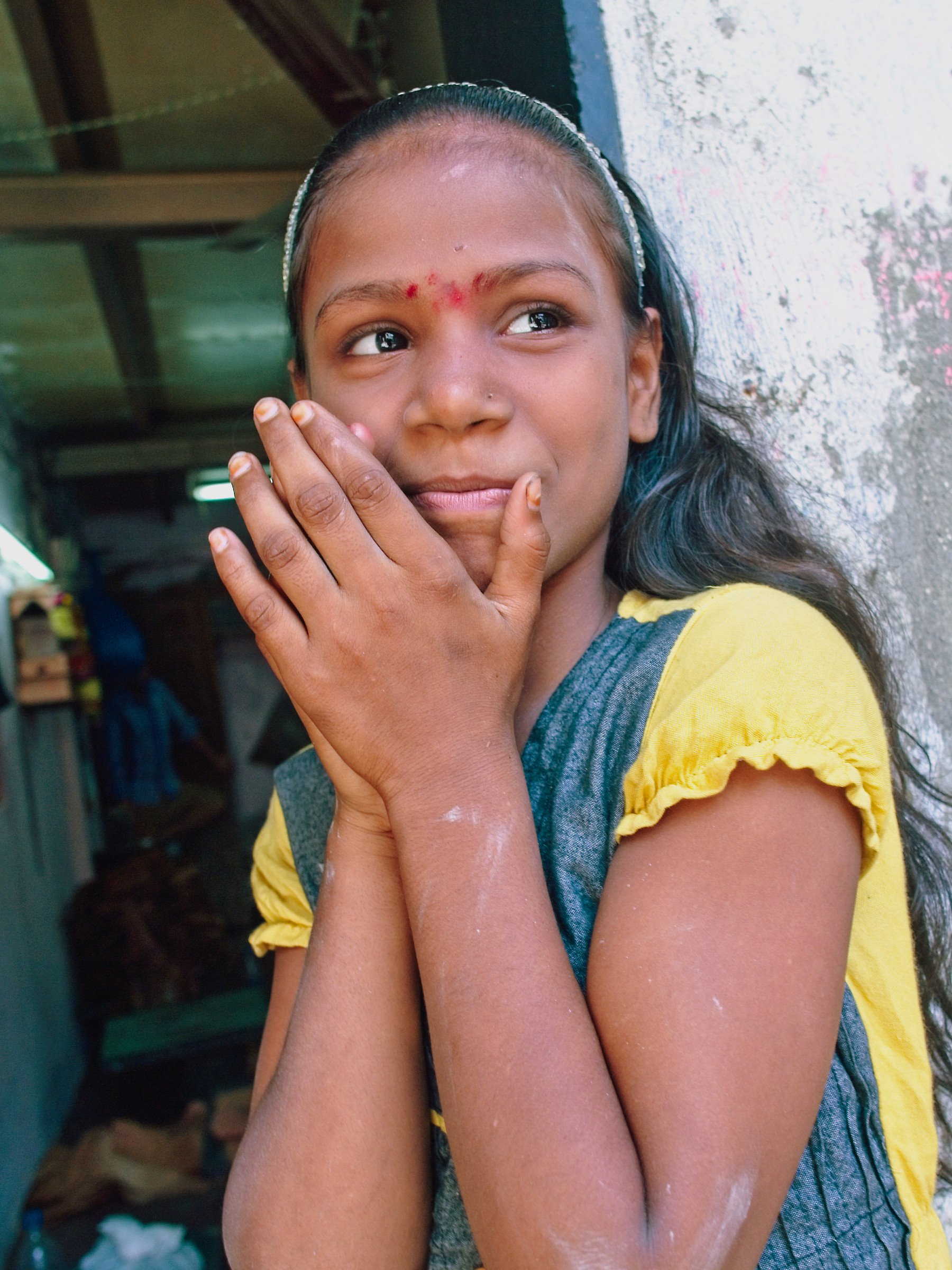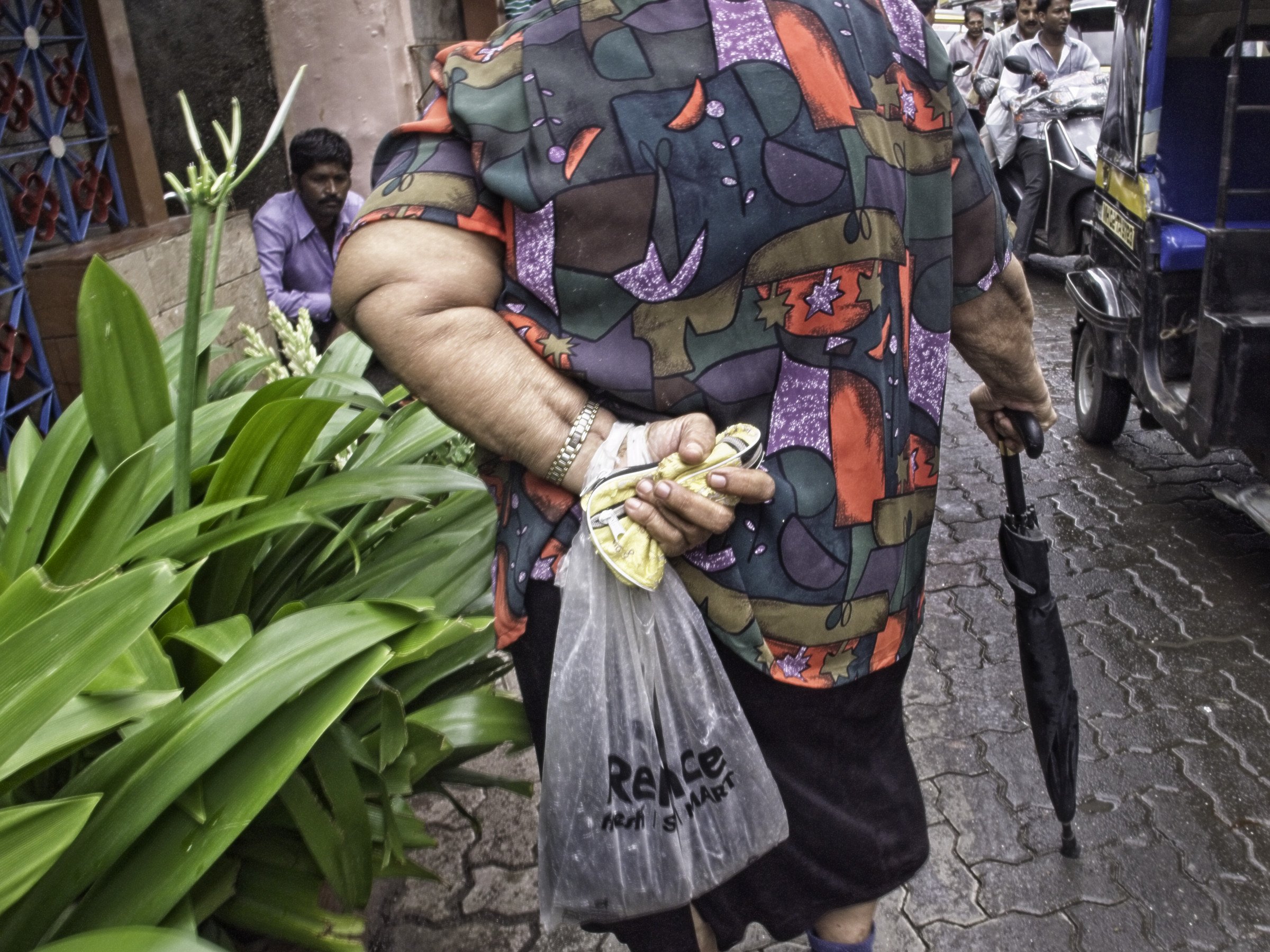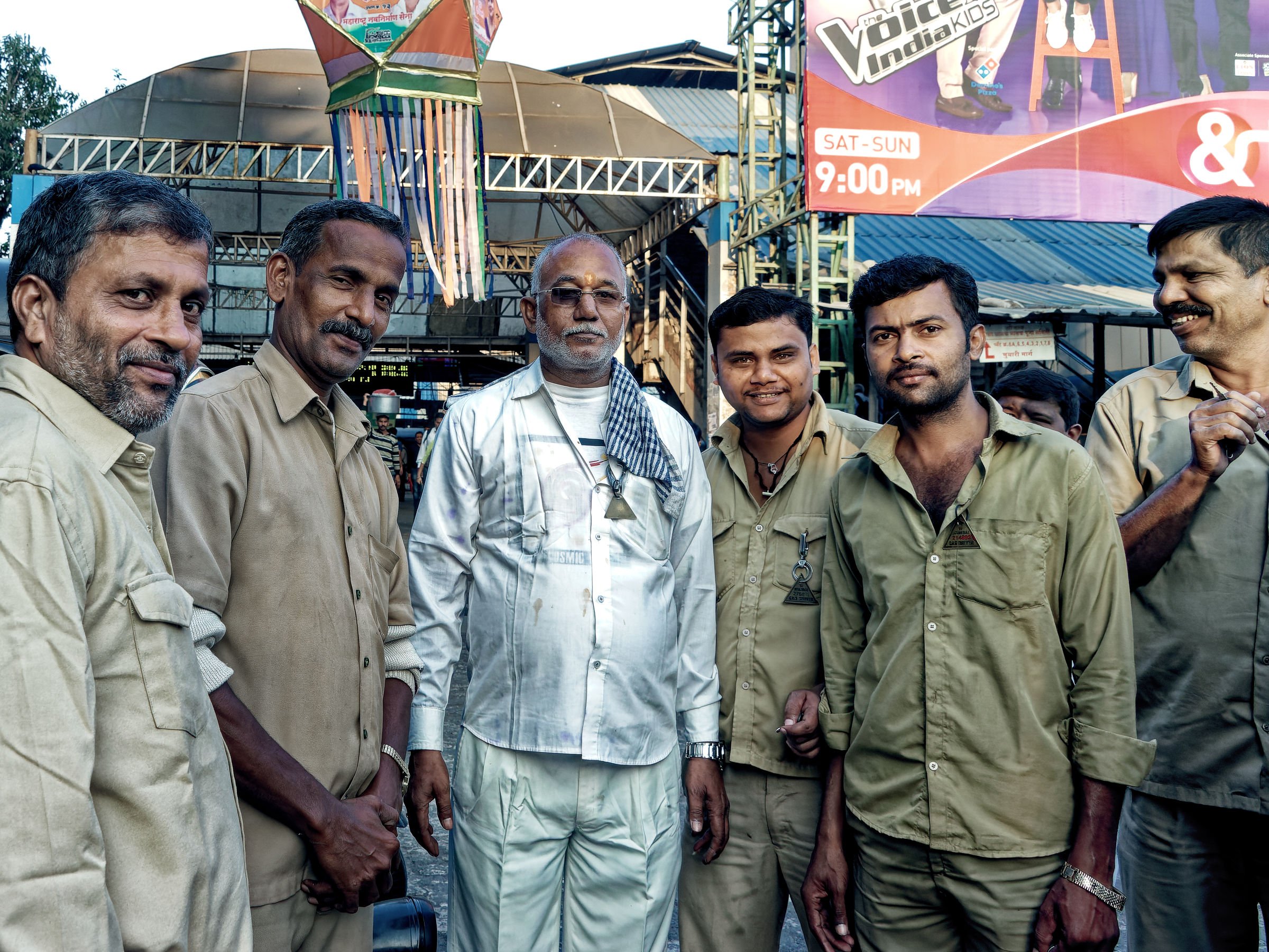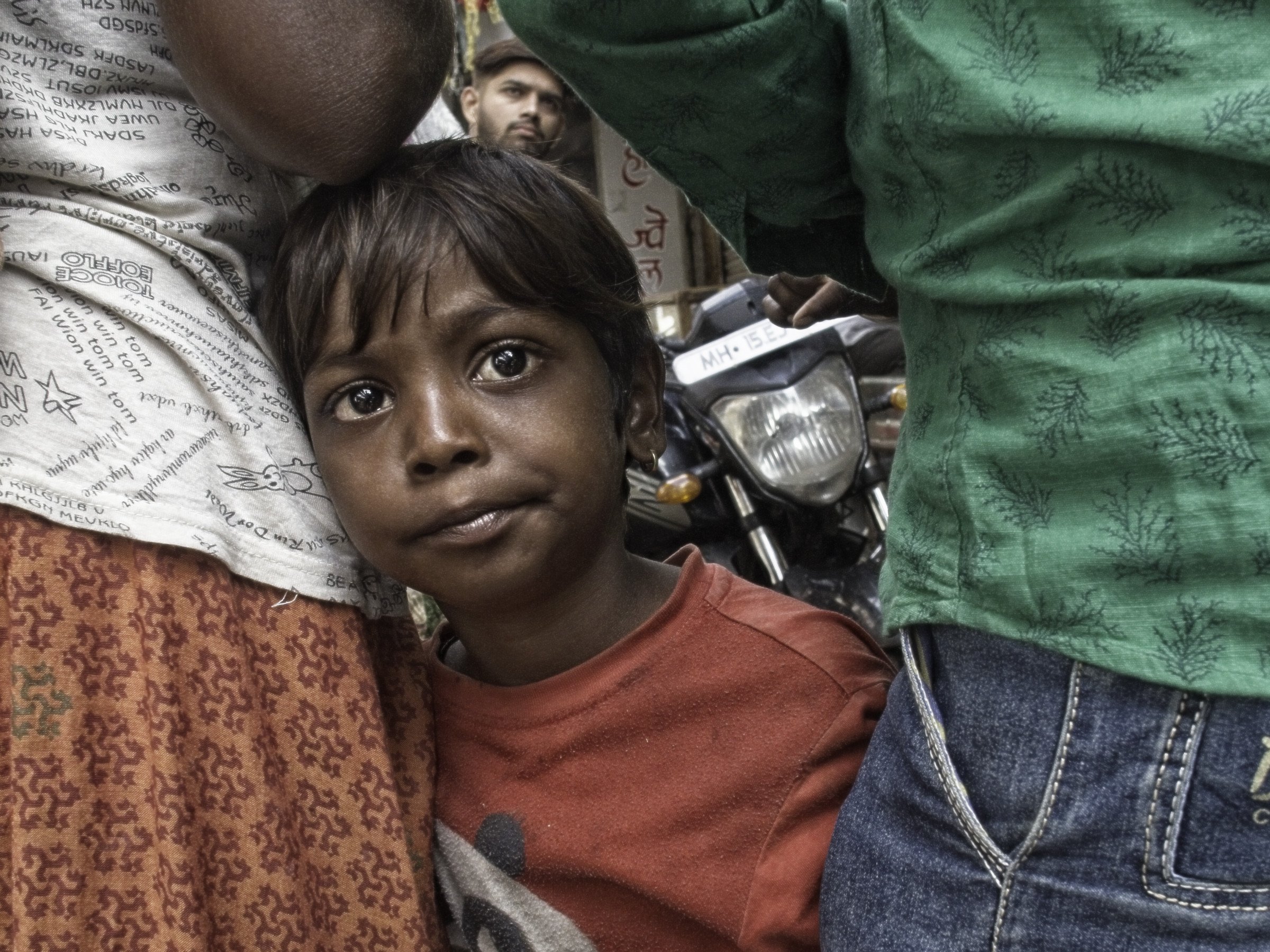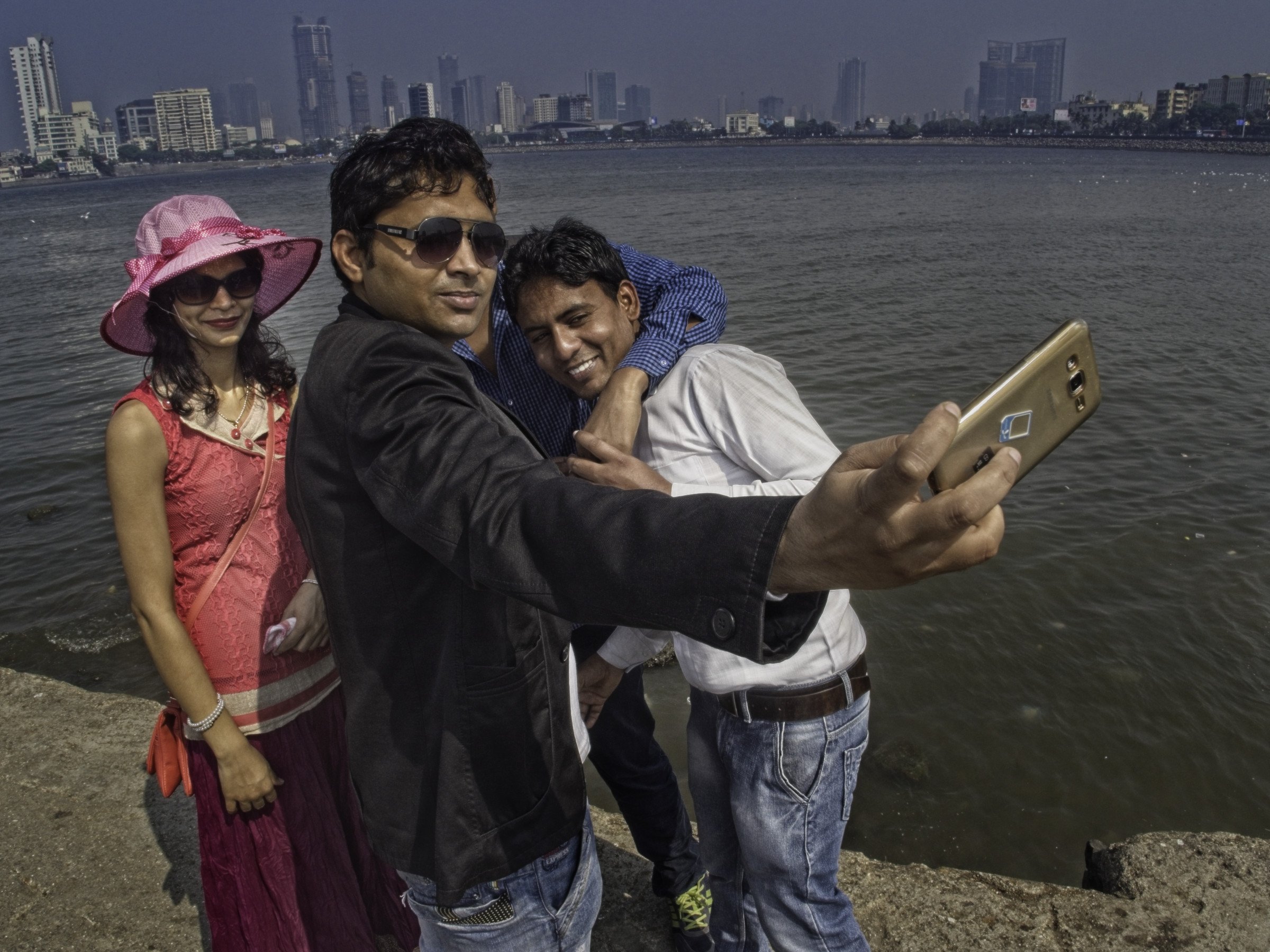‘Not The Taj’ is a project and a state of mind which looks away from the manicured India and seeks to find the beauty which lies in the every day life of 1.2 billion people even when this plays out in the pavements of Bombay.
Not The Taj - What is that all about?
Well, it took a while to work out a simple statement that kind of made sense and captured the essence of why, on the one hand, I ever took a terabyte of pictures on the streets of India and why, on the other, I ever felt compelled to spin a yarn about it. So here it is. I wish that in years to come, when India will be considered a developed country and has left the developing country club, Indian women will still feel confident and able to go about their daily lives wearing a saree. Not as some special day event but as a genuine part of everydayness. Whether in the fields, or the boardrooms, that is it! This site, these ramblings, full of cultural faux pas on my part, are just a record during a very rapid period of changes in India. I chose to record what may soon be an exception rather than the norm. This is a kind of diary of memories. A collection of thoughts. It is personal. Maybe, off the mark, questionable, infuriatingly pedestrian; nevertheless, it is a lens through which I discovered a whole continent of contradictions to fall in love with.
This is documentation of a love affair.
‘Not The Taj’ is a project and a state of mind that looks away from the manicured India and seeks to find the beauty that lies in everyday life of 1.4 billion people, even when this plays out on the pavements of Bombay.
India is a country which exists both in front of the development curve and behind it. In some cases a century or so behind it. It is, by all accounts, a country of contradictions.
India has 28 states containing 1.4 billion people, with an average of 5 people per household. This would translate to about 240 million garam masala recipes, and that’s enough material for many debates around dinner.
On a more serious note, India is where mothers are respected, but daughters are often despised. Sita is worshipped, but Nirbhaya, a girl on a bus, is brutally raped.
India can send a tin can into space at a fraction of the cost the Chinese can or spend a similar amount on gold building a statue for no other reason than iconolatry whilst millions of farmers struggle with dying crops.
India has more gold adorning its women folk's ears, noses and toes than some countries have as their bank reserves.
India is the world's largest importer of gold, with annual consumption of 800-900 tonnes. I had no idea there was so much gold around until I went there. Then, I also learnt that for many women, the gold attached to their noses, ears, feet, ankles, wrists and waists is all they have as security if their husband leaves them or dies and they are left to fend for themselves.
Today, some find themselves in a stretching game of Twister. One foot firmly behind the curve, tending dry farmlands, and a finger balancing ahead of the curve on a smartphone managing family finances with e-wallets.
Women can now save what they can, away from the guise of the men in the family. It allows them to borrow, start small businesses and become different examples to their sons and daughters. In a world of contradictions, emancipation can come digitally ahead of the ox and cart.
The thing about India is that if you can’t deal with its contradictions, go on holiday to Sweden.
On the other hand, if you enjoy the Duality of Particles in Quantum Physics, The Uncertainty Principle by Heisenberg and the chaos of opinions about anything from quantum mechanics to whether your mother’s masala is better than mine or anyone else’s, then India is for you.
This site is about the beauty of India beyond the beautiful forevers experienced in the luxury hotels of Rajasthan, the immense beauty of the Hills, and the eastern promises of yoga classes and tranquillity. The fraying charms left behind by The East Indian Company or the rights or wrongs of the British Empire.
All these are valuable for enjoyment, admiration, debate and fiery argument, mainly by the affluent middle and upper classes, Indian or Foreigners. They all have similar and predominantly western aspirations regardless of the place of birth. They are, however, of no consequence to the average Indian toiling the day away. Everyday.
This is about everyday India with its contradictions of kindness and cruelty, playing out on the pavements of Bombay, Delhi Kolkata. It is about the front and back of the curve. It is about life with a smartphone in one hand and a stick guiding an ox and cart in the middle of a motorway in the other hand.
I have gone out to shoot them as they are, not as I would like them to be. Some images will be very uncomfortable to western sensibilities. They are here not in any significant numbers, but they are necessary exclamation marks in the overall narrative of what I have experienced and what I would like you, the reader, to experience too.
Some are depictions of everydayness, and some are documentation of the slow journey the country is taking from the back of the curve to the middle and the front.
There are many that I hope to depict the dignity of poverty. I shoot what I see, and I edit to celebrate. There are some images where the context of location is essential. Families living on pavements is one thing.
When such a shot is taken in one of the most affluent neighbourhoods in Bombay or Delhi, it is not a comment about the subject, but one meant for its hosts. So when a location is mentioned in the picture caption, take note.
This book is about my accidental love affair with India. Each picture is a moment of flirting, whispering, endless talking, staring at the unbelievable naked beauty of innocence and romancing with strangers, all of whom have always been kind and welcoming towards me.
The few arguments and tiffs along the way have always been my fault and my ignorance of the cultural significance of certain behaviours I did not understand.
One mistake I made, particularly in the early days of my courtship with India, was to confuse its western aspirations as something which would always override deep Indian traditions and norms.
It doesn’t.
Once one understands that, the contradictions become revealing, sometimes infuriating but always didactic. So, as a result, this book is about finding out what certain things mean to me, a western pair of eyes and what they might mean to someone who lives and breathes the streets I try to document.
Not The Taj - Things to remember whilst reading this.
Toyota Innova: A tiny house on wheels sleeps eight, so it did….for 6 hours whilst stuck in Mahim during a spectacular downpour with street water almost to the door sills.
Mahim: The zone between Old Bombay and the madness of uncontrolled economic growth. Rickshaws can only operate north of Mahim. Some people from Colaba have never gone north of Mahim unless they have their passports on their way to the airport for Toronto, London or New Jersey.
Sula Brut: Imported champagne in India is criminally expensive. Couple this with the fact that, on occasions, a shipment from Europe can sit in the docs a little too long. Also, regularising paperwork is a national sport in India, second only to cricket.
In effect, you can pay a ransom to drink the early stages of vinegar.
Sula Brut is an excellent alternative if you are drinking to alter your mood, and quantity is necessary. It arrives in optimum conditions. It is devoid of snobbery and better than Waitrose Prosecco if consumed reasonably cold. It is also produced near some people very dear to me.
They include - A surgeon, his wife, who is a divine cook, their daughter, whom I have adopted as my own, and her school girlfriend - an engineer who runs a hefty manufacturing kit and bakes cakes. Their other school girlfriend is a Bollywood actress, her sister is good with words, and her father is handy with old bits of reclaimed wood surrounded by some lovely countryside.
Bandra: Not as exclusive as Malabar Hill and Colaba, but once you edge your way up the hill into Pali Hill, you are at the top end of snobbery by address and postcode. I edged up.
As I discovered over time, Bandra was and still is one of the best places to experience the contradictions of India’s emergence.
On the West, the Arabian Sea coast has a fishing community. A blend of lower-middle-class apartments and slum dwellings.
On the East, where the train line becomes its de facto fence, there is untold poverty in a narrow band of dwellings adjacent to the tracks.
To the South East, it almost kisses Dharavi across from the Mithi River.
To the North, Juhu. Upmarket enough to be Bandra’s neighbour.
Dharavi: One of the most densely populated areas in the world and Asia’s largest slum. Note: Kids walk out of that place to school in the morning like some invisible hand is squashing the area from above, and kids get squirted out of the alleys and into the buzz of Mumbai. They are always, always immaculately clean with pressed uniforms.
Pride and Poverty is a book waiting to be written. Probably in Marathi…
And so we start.
Kismet
Blind faith in kismet, like the opening batsman, simply putting his leg out to the draft of the ball in the hope that divine intervention will blind the umpire and the duty of wearing the ball down, somehow will be done.
This faith that things will happen, things will be better today as dawn breaks are both a strength and a curse. This is a positive outlook on the one hand for some, yet somehow a dead weight around the ankles of ambition for many others.
India has serene landscapes from Kashmir to Koodankulam and from Goa to Puri.
She has mountains, hills, lush tropical forests, and barren deserts.
India from afar is a shimmering mirage of a tranquil oasis. Together, her past glories, her painful colonial past, and her religious diversity have all collaborated to provide her with an irresistible choice of unique locations for luxury to indulge in splendid isolation.
India can seduce, pamper and flatter the thousands who flock in annually. Only for her to blindfold them inside the tinted windows of air-conditioned Toyota Innovas. Like some scenes from The Homeland, she delivers them in places far away from the growing pains of economic growth and cultural collisions.
She has a myriad of yoga retreats and serene temples. These worlds rarely cross paths with the daily lives of city workers who swarm on trains like locusts on a wheat field twice daily.
You often hear, ‘India is a place to find peace and tranquillity; discover yoga and relaxation; where you can spend four weeks in a silent temple.’
Not if, you exist in the shadows of the caste system.
In the words of V Venkateswara Rao in Outlook Magazine on account of another rape in UP on 6 October 2020, “How can such ugliness co-exist with the innocent beauty of the rural scape?”
Not if, you are on platform five at Borivali Station at 8 am on a long trip to work at Lower Parel.
Not if, you are hanging on for dear life in a State Transport Bus speeding away maniacally through the heart of Delhi with no door and non-existent widows, allowing the Delhi cocktail of air pollutants to reach parts of your respiratory system Covid can not get to.
Not if, you are the wife of the chap who just hopped on a commuter train with a tiffin full of lunch. A medley of rotis, some freshly made dal, pulao rice, Kolaphuri mutton, and a couple of gulab jamuns swimming in sugar syrup.
All prepared at 5 am before the first call of the Mumbai blackbirds. Then looking forward to a day spent with a stroppy mother-in-law and a couple of pre-school kids.
Not if, you are the rickshaw guy who worked a two-day shift fuelled by amphetamines, then slept folded like a swiss army knife on the back seat of his rickshaw; woke up, brushed his teeth with Colgate spread on paan (beetle) leaf, and started the cycle of inevitability again.
Not if, you are the hired driver of a swanky new Audi A6 in UN white, stuck in traffic in Thane for hours, inching forward at the speed of tectonic plates with a Tata short wheel truck millimetres away from your precious paintwork.
Not if, you are packed like a can of sardines in a tram in Kolkata. Certainly not if you are travelling through the night on the highways. Dodging AIP overloaded trucks attempting to overtake each other on steep hills. Or worse still, descending side-by-side using the brakes instead of low gears. Red hot glowing brake discs that eventually become useless and fade. Boiling the hydraulic fluid in the process. The solution in hand, a Ganesha on the dashboard and the dangling mirch with lime below on the front bumper.
Yes, let me tell you,
Horn OK, Please, is not a yoga chant to bring peace and tranquillity.
But enough of why I fell in love with India.
Not the Taj - A Journey of contradictions
India is a land where contradictions somehow manage to coexist. The managing director of the parent company who gave me the opportunity to fall in love with India, said to me in her sunny double height office near Paddington London,
‘If you can handle contradictions you will be fine. If not, I expect you will be back in 2-3 months. I managed two and half years and have not stopped going back for more ever since.
India is a world full of contradictions not just in the contemporary sense of wealth vs poverty. This world, is a result of the collateral inevitability of fast modern growth yes, but is also the result of colliding worlds of eternal argument and acceptance. A cultural dance, performed daily in generationally shared households, across a country where values, old and new, support and fight each other, constantly.
In his book the Argumentative Indian, Amartya Sen, tell us that even in the Vedas there is speculation about the world and difficult questions are asked.
Did someone make the world?…Does the God know?…
Some say it did,…who really knows ?…
Perhaps it formed itself,…Some say it did not.
In Ramayana, Sita is revered more than the Virgin Mary is in Christianity. Yet Indian women are not, and have not, for a very long time. Perhaps Valmiki put in enough seed of doubt to question Sita for all eternity.
All this, is reasonable fodder to argue and contradict over.
That said, it is a total mystery to me that with such rich veins to mine arguments and contradictions, there is no cafe culture to be found in India.
Israel and Greece, where similar traits of doubt and discourse exist, the markets are festooned with establishments who’s main purpose is to absorb the pressures of argument and contradiction over a cup of coffee and some chess or backgammon.
If India had cafes, I would probably have never left.
Here is an oddity I find difficult to fathom. Indians can argue like a Doosra flying through dense moist air at a test match at Chepauk and stump you before your arms know where your feet have been.
Fiery, defiant, focused, determined… yet, in the same breath, in the innings of life, there are those who would accept an existence determined by the origin of their surname.
The curse of castes is a fatal accident by birth.
And here are some contradictions
The contradictions of faith. India has faith in astronomy and astrology in equal measure.
It is most likely that the men and women who put together the Mangalyaan, the cheapest vehicle to ever overcome gravity and head for the heavens reaching Mars, before the guys on the other side of the Hills did, also consulted astrologists.
Chiefly, to determine the likelihood of a successful union with their yet unmet spouses.
The faith in science lives in perfect harmony with the science of faith.
Here is another uniquely Indian contradiction. Time.
I mention astrology. Millions of Indians consult it. Astrology is about the movements of the stars. Understanding this movement and position is all about time.
Yet the word in Hindi for tomorrow is Kal, and for yesterday it is Kal also …
Time in India is elastic. “It will be done in some time" is deliciously descriptive of how time in India works.
It is only when one accepts these differences that Ho Jaayega becomes a symphony. Inexplicably, Unfathomably.
Since I'm rambling about science, here is another set of contradictions involving probably the most controversial science faculty.
Two Gandhis, one nation, two sets of acronyms.
The shifting sands of contradictions.
Based on the founding principles of the emerging New India, the country refused to sign the Nuclear Non-Proliferation Treaty NTP on the basis that it did not lead toward disarmament and, therefore, against Mahatma’s ahimsa principles.
Nehru stayed true and atomic energy was mainly about generating electricity.
But, how do you stay authentic and, at the same time, remain relevant?
China could not care less and did what China does. Indira had to find a way around this; thus, a delicious Indian solution was born - PNE.
On 18 May 1974, under Indira Gandhi, India tested a fission device described as “a peaceful nuclear explosion.”
Job done.
But contradictions evolve with time.
They adapt and mutate to survive the changing conditions of a nation's gastric fluids.
In less than a day’s travel from any Metro City in India, one can straddle two centuries or more of technological evolution.
Picture this—a woman fetching water on her head. As many before her have done for centuries, but now, also holding a mobile phone.
This, for me, as my finger twitches over the shutter button of my camera, is an intoxicating surprise, not least for the promise it proffers.
A tiny plastic square with some jumbled-up nanowires has become the unexpected key to gradual freedom from centuries-old patriarchal domination.
A segway, to ownership, beyond gold on her ears, nose and toes. Access to digital banking without needing to sign a name she cannot write—a vote, free of manipulation.
For all her strong women at the helm, India does not treat women kindly on many levels of civil activity, which is the ultimate contradiction she has yet to face.
Managing contradictions
This can be done quickly by avoiding noticing them, not being sensitive to them or trying to understand them without the colonial urge to get them fixed.
That last one can get you into serious trouble with your mental health and the natives. Best avoid.
Contradictions suggest disharmony, inconsistency, and lack of coherency. But point out a contradiction to an Indian, and you will soon find yourself in a world of harmony and consistency.
It will come to you through a seemingly coherent argument as to why things may appear at odds when viewed through a western lens. But Sahib, please.... look at them through an Indian lens, then you will understand… See?
The world is in perfect balance. This, the path of avoidance, is often taken only if it involves an honoured guest in the conversation. When they all leave the factory, ‘India is Great’ is embedded in the Indian mind.
Accepting criticism about the country, let alone admit it to an outsider, is akin to treason.
'Mark'… I once said to a dear friend… 'I saw monkeys in Bandra'... ‘Ohh no, you haven’t ‘ we have not had monkeys in Bandra since the Britishers left' …. But when the honourable guest has flown back to their safe but dull suburbs, that’s when Indians argue. So after some time of grappling with colliding logic, I have come to see India as akin to sitting cross-legged in the middle of a Pollock painting just as he throws the paint on the canvas whilst my head is inside a Jimi Hendrix solo. Nothing makes much sense until you stand up and drink it slowly, sip by sip….from a distance. Soda lime juice is sweet and salty. It never tastes as good in Surrey as on a hot day in the streets of Madurai.
So Not the Taj results from staying the course and feeding on the contradictions. They wash over me as the Ganges washes over its polluted sediment. I don’t get fazed by them. I even celebrated them. They are what makes India, India.
Oh, well, three, four or five…perhaps.
A. Not everything is what it seems.
This is the most important insight. Look at it as a macro insight. Whilst others are micro insights.
B. Numbers are of a different magnitude.
Across all disciplines where numbers matter. People, Money, Gold, Food, Festivals, Length of Films, Distances, Length of Time…
C. Study the physics of osmosis.
As an honoured guest, it is the only way your wisdom - if you have any - will influence events.
D. Extracting benefit.
If you are a Britisher and feel guilty about the East India Company, by all means, continue, but no one in India cares anymore. They moved on.
So should you… ahhhh, yes, the Koh-i-Noor… let me say that extracting benefit from any situation is as popular as cricket… if you feel guilty, you have already lost.
My fellow Greeks want their Marbles back from the British Museum. My Indian friends want a stone back from the King of England, pride, yes, but deep down, it’s about poking to extract benefit. Both nations like poking.
D. Negotiations
Forget your lame win-win western courses.
If you want to learn to negotiate, work for a year at a procurement department in any big Indian business or as a street vendor in New Delhi. If you need air-conditioning to work, try these,
Tata, Reliance, Infosys …
Go in as an intern, survive on lentils and roti and go to work on the local trains.
Then go back to your fancy Western Business Centres and kick ass.
E. Language.
Not everything is what it seems … yes I told you macro insight!
The English language belongs to India. It is where it evolves the fastest and where most people on the planet speak it.
A grammatical masala of Hindi syntax with English words of old. Ohhh, so delicious and wonderfully blended.
It will take you three months of close listening to get the idea.
NOT THE TAJ - Avoiding clichés
Cliché 1: Westerners coming to India have, under the influence of a Kingfisher or two, solutions to India’s contradictions. If you are one, avoid having a view on this.
Cliché 2: There are many Indias. Anyone who has ever been to India more than once, in more than one place, anyone who has ever ventured outside the pampering of 5 Star luxury will tell you… ‘India is a complex place, with more than one India’. This observation sucks; it just states the obvious because the same could be said of Russia, China, or any other big nation.
Cliché 3: People photography is about making choices in fractions of time. It is probably the most common cliché in the genre since recording images moved from plate to film…
People photography is as diverse as the number of photographers who take a picture of strangers in public, and it is not all about the so-called ‘decisive moment’ but also about context. A picture of a migrant beggar in the streets of an EU capital may seem aesthetically similar to one in the streets of Bombay, but once in context, they are most definitely not. Not even if you consider the generic core reason for societal inequalities.
This isn't easy to understand, but in my experience, it is always what one sees in the eyes of the person in the picture.
Not The Taj is about the interplay of these clichés. In a way, Not The Taj is a portrait of my journey through India. A journey with me trying to avoid the Clichés and the Contradictions, like hopping over dog poo on the pavements of Bandra.
I doubt it is unique, and I do not offer any shuttering insights.
Not The Taj - Capturing Moments
The new republic of 1947 had good reasons to adopt socialist planning and a state-run economy. It is perhaps why a country with such diversity and contradictions was held together…. but things changed, …and the world outside was changing.
The last telegram in India was sent as late as July 2013. Thirty-one years after GB tapped out its own. It was sent to Rahul Gandhi. It marked the end of an era and a delicious symmetry of redundancy for both.
The digital world brought a revolution in communications, and at the same time, political dynasties ran out of radical genes. Times were changing.
The world inside was changing too. It grew more prominent, it grew more educated, and the traits which make an Indian child stand out, such as pride to succeed, family honour and all the rest of it, fuelled, and still does, a collective ambition to become the best. Duty over consequence …
This change has altered how India views itself and its future. Digital, more agile, younger, ambitious and confident to make mistakes unapologetically.
India is heaving with ambitious youth. That hunger exists across all levels of society. From the beggar kid selling trinkets at the highway underpass at the Thakur Village entrance outside the ‘Mahindra’ place to the offsprings of respected industrialist families from Ahmedabad taking over the industry reign respectfully dragging them into the 21 Century.
There is no doubt that for over 20 years, a change has been in the making. 2008 to 2014 marks perhaps the acceleration part of the curve. With it came rapid change, rapid growth, rapid shedding of the old, and rapid demand for the new. The filters of judgement could not cope and are still struggling to cope.
The mistakes are evident in the skylines of Delhi, Mumbai, and Bangalore. Whether it is in the planning of cities, the location of their airports, the failed traffic management, and a whole bunch of other activities, the point is that the so-called gradual transition into a market economy is unstoppable and will alter India… it is transforming India.
Please understand that I make no judgement and offer no solutions. It is an observation which fuels the need to capture the ever-changing 'everydayness of India' going about its basic chores whilst stumbling over its mistakes.
It is the backdrop which places Not the Taj in context.
Not The Taj - What brought this up you may well ask
In short, boredom , and being reasonably handy with a camera.
Here is the extended version….it is July 2012, monsoon season in Mumbai …I land on a Friday at 1 am at Chhatrapati Shivaji airport. The old one…the smell of heat, mustiness and bad plumbing gets hardwired into my nostrils.
I had the same happen when I landed in London from Athens for the first time in the late 70s and got on the Underground from Heathrow to Wood Green…
The smell of airports and undergrounds is the smell of a city’s armpit, and when you eventually fall in love, you miss it like hell.
Anyway…
I got stamped…
Then escorted into a Toyota Innova by a short Tamil Nadu guy who became my guardian angel during my time there.
I was driven to an apartment in Bandra…
Along the way, I am praying that the Innova would not stop…
not until I could see something vaguely western in style and cleanliness ….
next few days, I got my bearings around the hood…
after that… Monday to Friday … 8 am, I am driven to work in the Innova.
Worked in lovely air-conditioned offices, with enjoyable middle-class well-spoken colleagues ….in an almost finished new Tower…
6 pm I was driven home in the Innova.
Saturdays, Sundays again, I was driven in the Innova, to and from 5-star hotels mingling with other ex-pat lost souls….all saying how many faces India has….
then back on the Innova.
A month in, and I had to choose my contradictions… there is only so much Sula Brut one can have.
The opening scene in Apocalypse Now is where Martin Sheen is in bed drenched in sweat, and a flappy ceiling fan rearranges oxygen molecules, mixing them with dust.
There is a mirror scene, and although I did not break anything, I was very, very drunk at the time.
Next day….
I chose the street over the Four Seasons and the Lalit.
I ditched the Innova for the weekends and started walking with my camera.
Like Forest Gump, I have not stopped yet. Walking the streets of Indian towns is genuinely like a box of chocolates.
Here is a slight admission, I always thought that the Beatles were full of shit and all that guru stuff in India in the 70s was holy dung…. but I was wrong.
India is an acid trip. I can see that now.
Going to India and staying a bit to absorb enough of its essence, does have a perception-altering effect.
I now like the pink, yellow, and green colour combos. Even as a proposition for a Tuscan landscape painting.
Raw sienna is now dull as dal.
The greens of the Surrey Hills, you can keep.
I will take the drum rehearsals of the Ganpati festival over the silence of an early morning in the Welsh valleys.
Not The Taj - In Context
I was in India for a fraction of a moment, and like my pictures, my take is a moment in time. A time of Change.
One that started before I arrived but a time of acceleration, a moment that needs a high-speed shutter to register the changes.
In Not The Taj, I attempt to capture pictures that frame Indian Everydayness in fractions of seconds. One which changes faster than people think.
The petri dish of this whole idea is my experience of the rapid and uncontrolled changes that altered my own country Greece, in less than two decades. Ten million vs 1.2 billion, I hear you say…well that is what a petri dish is—a microcosm of behaviour to learn from. But Greeks are so different to Indians… you think!
I grew up in a two-family household. My grandmother at the top, a son’s family, a daughter’s family, some cousins and a dog.
The maid made me, amongst other things maids make.
Early on, during my time in India, I got a strange feeling of familiarity. Something about the humour, something about people’s lives in large family units, something about the emotional connection with food, it all felt comforting.
In his book, ‘Games Indian Play’ - Why we are the way we are - on page 16, V. Raghunathan lays out twelve canons of Indianess -
and I quote.
1. Low trustworthiness
2. Being privately smart and publicly dumb.
3. Fatalist outlook.
4. Being too intelligent for our good.
5. Abysmal sense of public hygiene.
6. Lack of self-regulation and a sense of fairness.
7. Reluctance to penalise wrong conduct in others.
8. Mistaking talk for action.
9. Deep-rooted corruption and flair for free riding.
10. Inability to follow or implement systems.
11. A sense of self-worth that is massaged only if we have the authority to break the rules.
12. Propensity to look for loopholes in laws.
I defy any Greek to suggest that these don’t apply to us.
Greeks and Indians have a diaspora so similar in behaviour. A practically identical transformation when they arrive back ‘home’ and ‘fall in’ as if they have never left.
Put them back into an international airport shipping out of the homeland, and their inbuilt chameleon cover turns them into indistinguishable westerners.
I defy any Greek to suggest that this doesn’t apply to us.
So yes, I can comfortably suggest that what rapid change did to Greece can and will in some way take place in India. Not in politics, not economically, not in a myriad of other ways.
Culturally, however, the aspirational growing middle classes will erode some of the uniqueness of the place. In the way it dresses, walks and talks, eats even.
The uncontrolled demolition of the old and the embracing of the shiny new will morph into what most things morph into these days. The blandness of Western,
Me Too…. please.
This is already in play.
There is a marked westernisation of certain retail high streets. Admittedly only evident in parts of Delhi, Mumbai, and Bangalore.
The Zara-saisation of retail may be slow, but it is inevitable.
Why, after all, should the average Indian teenage girl not look and feel like her NRI cousin in New Jersey, Toronto or West London? I could leave it at that, but I won’t.
A nation's confidence doesn’t just come from its technological and economic prowess.
It also resides in the uniqueness of its identity. The ingredients of its brand, and in India, are many. Unfortunately, they are so different from western norms that the aspirational youth is frightened of them.
When I think of India growing up in Greece, I see a woman in a dress I had never seen before, shaking hands with the power of the time Kissinger, Nixon, Brezhnev, and Castro.
For decades that was embedded in my mind, and I thought no more of India until one day I landed, walked the streets and realised the unique values of identity Indian clothing has for both males and females.
To be confident, one needs to be true, brave and have a grounded understanding of belonging. Blending in is a weakness.
Please don't confuse national identity with nationalism, but because the latter can be ugly, there is no reason the former should not be preserved, enjoyed, and celebrated.
NOT THE TAJ - Why is any of this relevant?
Well, in the years after my permanent residency ended and I returned to capture more Indian Everydayness, I observed fewer Sarees and fewer Kurtas. Admittedly not everywhere but certainly in the metro centres.
If this identity erodes in years to come, perhaps slowly, it will be like a melting iceberg reaching the point of no return. The outside heat will eventually overcome the frozen mass and turn the burg into a cube.
I would go as far as to say that it could be one of the most significant cultural vandalism.
In our western developed world, the street is used to travel from one destination to another, by foot or by motorised means. We are, generally speaking, popping in and out of trading establishments in an orderly and predictable fashion. Our Western high streets are places which signify stability, familiarity, and order. In the West, we generally walk in straight lines; we self-regulate pedestrian traffic streams. We fall in line behind others who walk in the same direction.
Well, try that in the busy markets of Kolkata, and you are likely to either be run over or never move. Ask my wife, who was attempting to cross Linking Road in Bandra less than 8 hours after landing in India for the first time.
Once again, In his book, V. Raghunathan has a go, with the aid of Game Theory Principles, at explaining why Indians don’t realise that if they collaborate, they can all benefit. He talks about how the desire of each to be ahead of others scuppers the chances of all avoiding bumping into each other.
Well, I am glad they don’t, because since I have learned to read the choreography, I can tell you it is a thing of beauty.
Let me tell you a secret.
The western street is about time management. People in the west have watches and alarms on iPhones. Everything is telling them to go to meetings. In India, the Hindi word for yesterday is Kal … the word for tomorrow is also Kal…. People in India have watches for status and alarms on iPhones telling them it’s time for lunch.
Indian time is elastic, fluid even. Like its great rivers meandering across large distances finding the route of least resistance to reach the sea. The goal will be reached, it may not be now or later, but it will be ‘in some time’.
This allows human activity to remain naturally non-linear since getting somewhere will always happen in some time. In the western street, unexpected randomness triggers alerts through security CCTV in Police observation centres.
Yes, fuck me… exactly. But… it is true.
Try running diagonally across Oxford Street from a normal stroll, and some sphincter will twitch somewhere on a screen in a police control centre. Suddenly go in the opposite direction, like a ball in a pinball machine and microphones hanging on chest holders will crackle. Romeo Alpha Bravo, we have a situation.....
Do that in, say, Calcutta, and everyone will assume you're trying to cross the street safely through flowing traffic.
So that will never work in India.
Unexpected randomness would take an entire Amazon Server Farm in Arizona to compute its likely permutations.
Unexpected randomness in India is like an Avant guard ballet played on a mass scale.
Capturing moments here is about reading the choreography of the street.
It is the key ingredient of why capturing people in her streets is such a joy.
Indian streets are, of course, far more than that.
To say that the street in India is a ‘stage’ like perhaps NY or LA is for ‘the look at me crowd’ is woefully off the mark. Insensitive even, possibly with patronising overtones too.
Indians love to be in a frame but are not acting out.
Life takes place there because it has to.
India is in an economic transition period that is brutally fast at times. It hasn’t had the time to think things over.
As a result, village life came to the pavement next to a sexy new tower block. The gates open to gobble up or spit out shiny German motorcar engineering a few feet from a three-year-old naked child urinating on the pavement curb.
Life on the streets in India is evident in all its forms.
Lois’s advice came in handy … ‘If you can handle contradictions, you will be fine. If not….
NOT THE TAJ - Food
India offers unsurpassed hospitality and food to its guests.
North to South, East to West, Veg India non-Veg India, a myriad of dishes with the same name but very different tastes depending on where it was cooked, what was the occasion it was cooked for, and by whom it was cooked.
One’s mother or grandmother is always the most famous cook.
Jamie Oliver is occasionally mentioned, but that is generally from a large Indian family with many NRI members or anyone in Bandra.
Food is very pivotal to Indian culture. It is a sign of wealth, and providing it in abundance is a social comment as much as the BMWs lining the neighbourhoods of the emerging middle classes.
On another level, Chai and hastily roasted peanuts are offered to passing strangers, beckoned to visit humble dwellings in small country villages.
It is a symbol of kindness and community, famously celebrated in the Sikh langar of the Golden Temple, where 100,000 souls are fed a complete meal every day.
Here in lies another thing about India: numbers and scale. Or the scale of the numbers.
Remarkably, I have not encountered many contradictions on the food front despite the food being such a big thing in India.
Apart from one.
The flavours in India are beyond a measurable scale. They have depth when they are not buried under the heat of too much mirch. They also have the patience to linger on your taste buds for as long as possible before your next sip of Kingfisher.
Yet despite this, Indians drown their food with Ketchup as if Mahatma put Ketchup on the constitution just after the notion of non-violence.
NOT THE TAJ - A personal journey of discovery for me and my camera
These kinds of journeys are often very personal. They are conditioned by previous life experiences and how we view the world. The older one is, the more prejudiced the storytelling of the journey becomes. For that reason, Not The Taj has a faux pas fixer. Her name is Noopur Pradeep Shukla. We shall converse, discuss or argue in the best Indian tradition over the photographs. One Western import sniffing for hidden clues of culture hidden in the armpits of Kali. One desi Indian pointing out how life tastes every day, bereft of sentimentality
One-click two minds.
Another book I read during the first few months in India was titled Behind the Beautiful Forevers by Katherine Boo.
I bought it at the airport on my first short return to Surrey. I read it without a break on the 9-hour flight.
It was moving and gave me some insights into Indian day struggles. It was only later that I discovered this was no fiction but Boo’s journey of discovery following the lives of real people in a slum.
Boo says that her characters are not representative of every Indian, which is true. At least in my experience, what is represented is the spirit of endurance, the heart of can-do, and the nature of doing the needful. Whatever it takes, to wake every morning and believe that today is the day for a brighter future.
At this time in my Indian excursion, I ditched the Innova at weekends, picked up the camera, and went looking for the places behind the beautiful forevers.
Cerca Trova, they say in Italian..’ seek, and you will find’ This pronouncement on a little green flag hidden in the chaos of a Tuscan battle scene. It is often mistaken as some motivational call to enquire and be rewarded…
Well, it is not.
In the context of the painting, The Battle of Marciano, the patron of the painting was sending a message to those who lost the battle, saying yes, you looked and searched, but all you found was horror. Or, as the Chinese may say, beware of what you wish for.
I searched, and I found difficulty. Difficulty to comprehend how Indians can be, on the one hand, paradigms of hospitality, selfless to their children and family, yet so cruel to other Indians. Difficulty in restraining myself from attempting to fix things around me. Difficulty in understanding how other westerns can be so blind to their
‘ colonial behaviours’
The very ones they condemn in their polite conversations with each other. Whilst neglecting their drivers who are stuck outside the swanky 5-star hotels and shouted at if they disappear for 5 minutes to take a leak against a garden wall. Or worst still, they are dismissed without notice for using the engine to keep the car AC running in 40C of heat with hours of waiting ahead of them. Company cars you see need to save on diesel, or the user has to pay everything above the company allowance. Difficulty in accepting the Gita thing and the treatment of women. Difficulty in accepting that Delhi can be thought of as civilised.
So yes, Chinese wisdom is correct to say beware of what you wish for. But I am a sucker for a challenge. So here we are.
To avoid the horror of what my enquiry presents me with, I once again had a good think about managing the contradictions.
Here is something from the Argumentative Indian by Amartya Sen :
Duty and Consequence.
Arjuna is torn between doing his duty and the consequences that may bring. Krishna argues that duty is paramount. Arjun questions if a just cause is all that matters. Krishna, skilled in the art of argument and persuasion, overwhelms Arjun with principles of action. Krishna removes Arjun’s doubts.
Why is this relevant to this journey of discovery for a man with a camera, I hear you say…
Not The Taj - From curiosity to understanding
There is a difference between a tourist and a traveller—between a vouyer and an observer. There is a further difference between a traveller and someone who arrives for economic reasons. They will peak and observe, but in return for the benefits, it is also a duty to absorb and understand.
When I started shooting people in the streets of Bandra, it was no more than a photographic exercise. Capture what to me seemed different, odd, sad, and hilarious.
It was all about Curiosity.
Over time, my ignorance of Indian culture became a little more informed. I felt more comfortable flowing through body-saturated streets where personal space is mutually surrendered without a second thought.
I started taking different kinds of pictures. Pictures that looked into people’s faces. At this point, things became different.
It was not until later that I understood how different.
Gary Winograd took thousands of street pictures on the streets of the US and NY in particular. He often did not develop the film until months after. He made this observation. Street photography is a physical and emotional event.
Another one of my photographic heroes Don McCullin, recently did a small documentary shooting in Kolkata's streets, making the same point and physically demonstrating how immersive this can be.
More often than not, you get attached to the buzz of the day. Selecting pictures soon after that makes your judgement fuzzy. So he did not. I try not to. It is more difficult not to peak with digital photography. Far easier to throw a film can in a draw and forget about it, which he did. They found thousands of them when he died. Now, the property of the MOMA in NY City.
The main difference in transitioning between curiosity and enquiry, for me at least, was a sense of understanding of the culture, an empathy with the subject and an emotional connection.
I can now review pictures taken a few years back and identify the ones where key Indian traits are evident in the eyes, the body language the expression of the subject.
None of this was, of course, consciously pre-meditated. I have taken thousands of pictures of Indian street life since mid-2012. Many are dull; many are repetitions; many are a simple record of something about to vanish. However, there have been pictures that unlocked paths to new directions.
Sometimes it was because they were challenging to take, or being where I shouldn’t have been, disobeying some ‘no entry’ sign and crawling under the concrete structures of a Mumbai underpass to shoot dead rickshaws, or shooting a naked kid taking a shower in public view, or shooting six serious surgical operations over a period of a week and many others which would come under the term of breaking a physical or mental barrier.
Then there are the ones where I look into people’s eyes as they go through their daily life in difficult circumstances. These are the most rewarding as my intrusion becomes a captured acknowledgement of appreciation. I have no idea if the following statement is true, but here it is anyway.
India has 1.4 billion souls. Millions are invisible because of the numbers but often because of their Caste and Gender.
Randomly pointing the camera at a person doing their daily chores in a slum on the edges of Malabar Hill in Bombay often produces a unique brief relationship.
One that often produces a sense of bewilderment, surprise appreciation, and rarely resentment.
That is where the beauty of India is hidden.
Not The Taj
NOT THE TAJ - A hostage
In Homer’s Odyssey, Odysseus was told by Circe to put beeswax to his ears and tie himself to the mast of his boat as he passed the islands where the Sirens lived. Bugger… I forgot to pack some rope and blindfold when I left Surrey. And so I became a hostage to her—a sort of Stockholm Syndrome victim, perhaps.
Most likely a hopeless romantic impersonator of Alexander's habit of absorbing the culture of the conquered. Until one day, one becomes one. In this day and age, when every human condition is in search of recognition that defines it and perhaps offers an identity to those who need reassurance, I am assured that I now can belong to a group of people under the spell of India. The India Syndrome is now a recognisable condition, but in my case, it is not one I wish to be weaned off.
NOT THE TAJ - And I leave you with this thought
If you are an Indian National or even a posh NRI, I can promise you without any hint of doubt that nothing I have said or have ever photographed is a criticism of the Nation.
One notable exception is the treatment of women within India.
Many aspects of the growing pains of a nation can be overcome by the application of industry and the will to succeed. The treatment of women is not one of them.
It is about the application of values—Indian values for that.
There is nothing to suggest that India needs to import western norms to overcome this blot. Not western feminism, not ‘me too’, or cancel culture, from the cesspit of Twitter.
It has its references to moral values going back centuries before external influences gave men the license to abuse… and perhaps just perhaps, mothers need to apply their personal experiences of growing up when the time to raise their sons comes.

